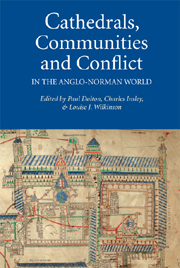Book contents
- Frontmatter
- Contents
- List of Illustrations
- List of Contributors
- Preface
- List of Abbreviations
- Introduction
- 1 The Dangers of Invention: The Sack of Canterbury, 1011, and the ‘theft’ of Dunstan's Relics
- 2 Remembering Communities Past: Exeter Cathedral in the Eleventh Century
- 3 Communities, Conflict and Episcopal Policy in the Diocese of Lichfield, 1050–1150
- 4 The Acta archiepiscoporum Rotomagensium and Urban Ecclesiastical Rivalry in Eleventh-Century Rouen
- 5 Cathedrals and the Cult of Saints in Eleventh-and twelfth-Century Wales
- 6 A Bishop and His Conflicts: Philip of Bayeux (1142–63)
- 7 Ecclesiastical Responses to War in king Stephen's Reign: The Communities of Selby Abbey, Pontefract Priory and York Cathedral
- 8 Secular Cathedrals and the Anglo-Norman Aristocracy
- 9 The Lives of Thomas Becket and the Church of Canterbury
- 10 Caught in the Cross-Fire: Patronage and Institutional Politics in Late twelfth-Century Canterbury
- 11 Crown, Cathedral and Conflict: King John and Canterbury
- 12 The English Monasteries and their French Possessions
- Index of People and Places
- Other Volumes in Studies in the History of Medieval Religion
1 - The Dangers of Invention: The Sack of Canterbury, 1011, and the ‘theft’ of Dunstan's Relics
Published online by Cambridge University Press: 12 September 2012
- Frontmatter
- Contents
- List of Illustrations
- List of Contributors
- Preface
- List of Abbreviations
- Introduction
- 1 The Dangers of Invention: The Sack of Canterbury, 1011, and the ‘theft’ of Dunstan's Relics
- 2 Remembering Communities Past: Exeter Cathedral in the Eleventh Century
- 3 Communities, Conflict and Episcopal Policy in the Diocese of Lichfield, 1050–1150
- 4 The Acta archiepiscoporum Rotomagensium and Urban Ecclesiastical Rivalry in Eleventh-Century Rouen
- 5 Cathedrals and the Cult of Saints in Eleventh-and twelfth-Century Wales
- 6 A Bishop and His Conflicts: Philip of Bayeux (1142–63)
- 7 Ecclesiastical Responses to War in king Stephen's Reign: The Communities of Selby Abbey, Pontefract Priory and York Cathedral
- 8 Secular Cathedrals and the Anglo-Norman Aristocracy
- 9 The Lives of Thomas Becket and the Church of Canterbury
- 10 Caught in the Cross-Fire: Patronage and Institutional Politics in Late twelfth-Century Canterbury
- 11 Crown, Cathedral and Conflict: King John and Canterbury
- 12 The English Monasteries and their French Possessions
- Index of People and Places
- Other Volumes in Studies in the History of Medieval Religion
Summary
In 1184 Glastonbury Abbey experienced a disastrous fire, which necessitated a general rebuilding. Money was urgently required, and it was presumably in an attempt to boost the lucrative pilgrim traffic that the monks claimed to have discovered — or rather rediscovered — the remains of no less a person than St Dunstan, one-time abbot of Glastonbury, and archbishop of Canterbury. The story of the finding of the relics, and their original arrival at glastonbury, is narrated in a long passage added to William of Malmesbury's De Antiquitate Glastonie Ecclesie. It tells how, during the reign of ‘the famous king Edmund, called Ironside in his native tongue’, the Danes landed in eastern England, and brought the whole of Kent under their control. Among other atrocities, they captured Ælfheah, archbishop of Canterbury (1006—12), drove the monks from the metropolitan church, ‘and destroyed everything by fire’. Presently King Edmund came to Glastonbury, and described to Abbot Beorhtred and his monks how ‘the church of Canterbury had been burnt and entirely bereft of inhabitants and religion’. The Glastonbury community then begged the king to let them fetch the relics of Dunstan to their own house, and Edmund readily agreed. Four named monks were selected to lead the expedition, chosen because they had once accompanied Dunstan from Glastonbury to Canterbury, and after his death had ‘committed his body to its burial place’; they had then remained at Canterbury until Ælfheah's martyrdom, after which they returned to Glastonbury.
- Type
- Chapter
- Information
- Publisher: Boydell & BrewerPrint publication year: 2011



